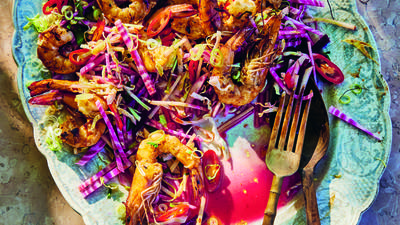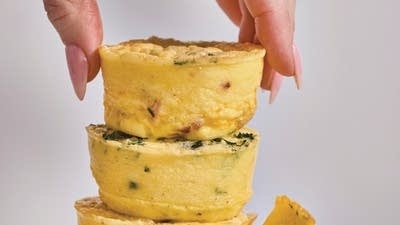
Nongkran Daks, author of Nong's Thai Kitchen, has been making Thai curries since she was 7 years old.
Lynne Rossetto Kasper: When did you first start making curries?
 Nongkran Daks
Nongkran Daks
Nongkran Daks: When I was 7 years old, my parents were separate; they went two different ways. My father left me with my sister-in-law, who was a caterer in the southern part of Thailand. In that part of Thailand, we always eat curries for three meals a day -- breakfast, lunch and dinner.
LRK: You were the one making the curries at 7 years old?
ND: Yes.
LRK: That's a complicated thing to do.
ND: My friend called me Cinderella because I had to do something to help them. My sister-in-law, who was a caterer, would put ingredients on a tray, a pinch of this, a pinch of that. She said, "You must remember, because tomorrow you have to do this again and again." I had to count how many peppers were in there, how many garlic cloves and shallots. That's how we started.
LRK: I think most people use the curry paste that you can buy in the store. When they look at a recipe for Thai curry and they see the long list of ingredients, they're totally intimidated. Can you walk us through how you do a curry paste?
ND: First, you have to choose what kind of curry you're going to make -- we have red curry, green curry, yellow curry, sour curry and so on. Then you have to choose the meat to go in there. It could be chicken, pork, beef, lamb or goat. In the South we don't really have lamb, so we use goat.
The first curry you make should be the one that has the fewest number of ingredients. For example, in my cookbook the Kang Kai Kole is the easiest and one of the best. It has only eight ingredients altogether, including chicken.
You have a blender. You start with chile peppers; this one uses the dry, long chile pepper, the red one. You soak that in water for 20 minutes until it is nice and soft. Just throw it in the blender. Follow that with some garlic, shallots, coriander seed that is already dry-fried in the pan and half of the amount of cumin.
LRK: Whatever amount of coriander seed you have, you'd use half that amount of the cumin seed?
 Nong's Thai Kitchen
Nong's Thai Kitchen
ND: Yes. With 2 teaspoons of coriander seed, you would add 1 teaspoon of cumin seed.
Then add some turmeric powder or fresh turmeric, which now in Asian grocery stores is not hard to find. Add some cinnamon, salt and shrimp paste. Put a little water in and blend it. That's all.
LRK: How do we cook the curry paste?
ND: You put a little oil in the pot that you want to cook the curry in, then you quickly stir-fry the curry paste until it smells fragrant, maybe 2 or 3 minutes. Add the coconut milk in there and let it boil again. Put in a big chicken piece, a chicken thigh. You can also use it with fish or some other meat, but I think it's meant to be with chicken. Cover it and let it cook about 40 minutes until the chicken is tender.
This same curry paste, after you put the coconut milk in, becomes very thick because there is no other liquid in it. You can soak the chicken in it and then grill it.
LRK: Use it as a marinade?
ND: Yes, a marinade for grilled chicken.
LRK: What's a more complicated curry?
ND: Massaman curry or panang curry are also from the southern part of Thailand.
The massaman curry is the most complicated; it has cinnamon, cloves, nutmeg, lemon grass, galangal, shrimp paste and salt. All of the ingredients have to be dry-fried on a pan, so all of the flavor comes out. You blend it the same way you blend other curries.
Cook it in a little oil until the rawness is gone, until it smells fragrant. Then you add typically beef, so it needs to be cooked a longer time. There is potato in there. The flavoring that we use is an equal amount of fish sauce, tamarind juice and palm sugars. This is my mother's recipe.
For the tamarind juice, you buy tamarind paste. Use one part tamarind paste to three parts water. You soak it, just leave it there and forget about it. But if you are in a hurry, you soak it in hot water and you smash it. Then drain it to remove the pulp from the liquid. You use that liquid for flavoring the curries and sweet and sour things. We use a lot of those in place of vinegar.
If you don't have palm sugar, you can use light brown sugar.
 Daks' recipe: Panang Beef Curry
Daks' recipe: Panang Beef Curry
LRK: If we can't get the red Thai chiles, is there any other kind of chile we can use?
ND: There are Mexican peppers; with their shape and length, they look just like the Thai pepper. It's called puya. It's very funny because the word puya means grandfather in Thai. "Pu" means paternal grandfather and "ya" is maternal grandmother. Grandparent peppers.
Before you go...
Each week, The Splendid Table brings you stories that expand your world view, inspire you to try something new, and show how food connects us all. We rely on your generous support. For as little as $5 a month, you can have a lasting impact on The Splendid Table. And, when you donate, you’ll join a community of like-minded individuals who love good food, good conversation, and kitchen companionship. Show your love for The Splendid Table with a gift today.
Thank you for your support.
Donate today for as little as $5.00 a month. Your gift only takes a few minutes and has a lasting impact on The Splendid Table and you'll be welcomed into The Splendid Table Co-op.




